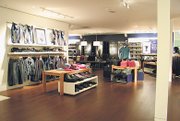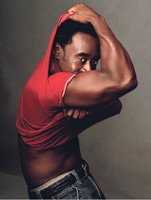The Gap: Back in the Black?
Is The Gap Inc. making a recovery?
After more than two years of declining sales, the San Francisco–based retail giant has many analysts speculating that the company had lost its business savvy. However, others believe that Gap is on the road to recovery with a new focus on its forte—basic clothes—and a slate of celebrityfilled marketing campaigns.
San Francisco–based Pacific Growth Equities retail analyst Christine Chen thought that the company had made improvements in merchandise margins and reported anecdotal evidence that its Audrey Hepburn and (Product) Red marketing campaigns were embraced by consumers. She wrote in a Nov. 3 research note that the time was ripe for Gap to bounce back.
She said that Gap is approaching the end of a two-year cycle where it has been in the process of recovering its fashion direction after committing a serious merchandising error in 2004. That year the company hired former Marc Jacobs designer Pina Ferlisa to produce fashion-oriented collections for its central Gap brand. It was a change from the basic clothes of T-shirts and jeans, which helped build the company’s reputation in the 1970s and 1980s.
Ferlisa left the company in October 2005 and was replaced by Charlotte Neuville as executive vice president of design. Chen said the change in direction was more in line with the desires of Gap customers.
“They don’t want fashion-forward. They want black pants and white shirts,” she said, noting that the retailer’s recent Audrey collection features stylish but simple garments. “Gap’s merchandise got better, but people don’t know it yet. [Gap] needs a couple of quarters of good merchandising and that will bring people back.”
Other analysts said they thought that Gap’s proverbial light at the end of the tunnel is still far away. Robert Buchanan of St. Louis–based A.G Edwards & Sons Inc. wrote in a Nov. 2 research note that the retailer was continuing to make fashion mistakes. He forecast that its operating margins were in danger of further decline and that the company would lose valuable market share to its competition.
“Abercrombie & Fitch and other fashion stalwarts are getting smarter and otherwise better all of the time,” he said.
The announcement of Gap’s third quarter earnings on Nov. 2 did not bring good news either. The company said it earned $3.86 billion for the 13 weeks ended Oct. 28. It was flat compared to the net sales of the same period the previous year. The third quarter’s comparable sales decreased 5 percent compared with a decrease of 7 percent in the third quarter of 2005. The Gap did not respond to calls for comment by press time.
New concept stores
The disappointing financial news comes amid the company’s first stab at multi-line retailing.
On Nov. 1, Gap Inc. Direct, the company’s e-commerce division of San Francisco– based Gap Inc., debuted Piperlime, an e-commerce footwear store that sells men’s, women’s and children’s shoes. The Web site deals in brands such as Tsubo, Ben Sherman, Frye and Timberland. Price points range from $85 for the Moon sneaker by JShoe to $325 for the Steven boot by Steve Madden.
The venture may represent a big change in Gap’s business. It is the company’s first business where it sells other companies’ brands and where it employs buyers.
(The footwear retail business has become a popular place to explore for specialty apparel retailers. In September, Bebe Inc. debuted footwear and accessories concept Neda by Bebe at the Westfield San Francisco Centre shopping mall. Last year, Pacific Sunwear debuted its own footwear concept store, One Thousand Steps, which has since opened in more than six malls across the United States.)
Chen forecast that Piperlime would have no effect on The Gap’s bottom line, at least not in the near future. “It’s so small that it won’t have an impact yet,” Chen said. “But [footwear] is an untapped opportunity. [Gap] is competing with department stores.”
On Sept. 18, Gap announced a design collaboration with U.K. designer Roland Mouret. The capsule collection of dresses is being offered mostly at European-based Gap stores and a handful in New York.
And last August, the retailer debuted its first new brand concept in 10 years, Forth & Towne, a chain for women aged 35 and up. By the end of 2006, Gap Inc. will run 19 Forth & Towne boutiques, according to a company statement. The store aspires to offer the deep selection of a department store by selling four store lines called Allegory, Prize, Vocabulary and Gap Edition.
Get it quicker
Gap’s new ventures may not be a match for the burgeoning challenge of fast-fashion stores such as Los Angeles–based Forever 21 and European retailers such as H&M and MNG By Mango, which have all made a push to expand in the United States market in recent years, according to Mercedes Gonzalez, director of New York–based buying office Global Purchasing Companies. The company also reports trends to Standard & Poor Inc.’s Vista Research.
“They’re always a day late and a dollar short,” Gonzalez said. She criticized Gap Inc. for not being able to jump on trends such as the skinny jean early enough. She contended that consumers were running to stores to pick up skinny jeans in early spring, but Gap officially debuted its marketing campaign for skinny jeans on July 17.
Gonzalez argued that retailers, including Gap, will increasingly have to follow the lightning-quick speed of stores such as Spanish retailer Zara in getting designs from concept to floor. Zara reportedly takes less than six weeks to design, manufacture and distribute fashions. Gonzales said that consumers are expecting fast speed-to-market campaigns more. Gap is making an effort to speed up the production process— beginning at its lower-end Old Navy stores. The company recently reported that production cycles have been cut on some Old Navy clothes from a nine-month production cycle to a three-month production cycle.























